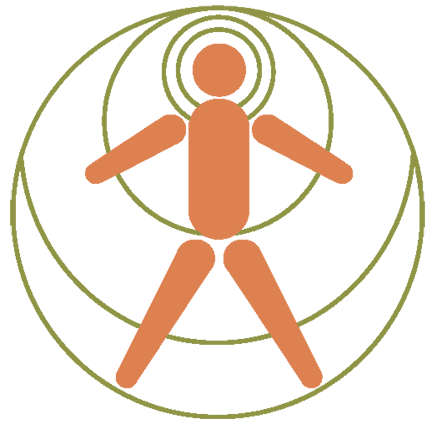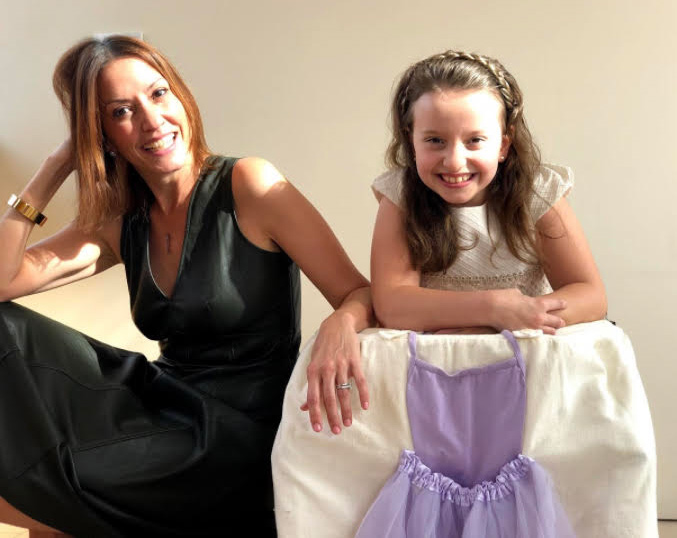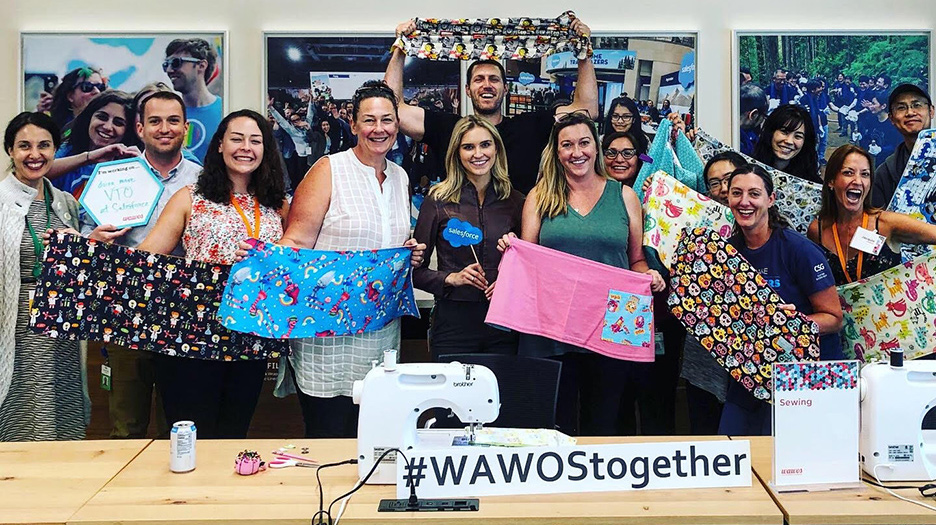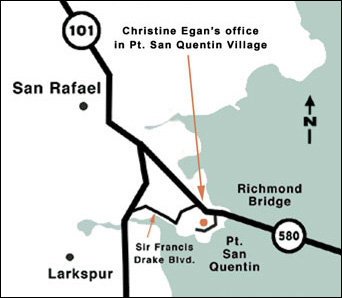Christine Egan Physical Therapy
Christine’s Pediatric Physical Therapy Blog
Sofia & Jacquie: A Dynamic Duo
Sofia Robison is an accomplished 10-year-old. She takes level two ballet classes from the Dance Training Center in San Francisco, excels in her fourth-grade class and is fascinated with robotics and cooking. She avidly swims and skis. Her mother, Jacquie Robison has often reaffirmed that Sofia’s Cerebral Palsy is the least interesting thing about her.
“It’s such a footnote to who she is and I feel like it’s really important for us as a family to live that,” Jacquie said. “How would any of us feel if we were defined by the thing that is the least of us?”
Ever since her daughter’s Cerebral Palsy diagnosis, Jacquie has made it her mission to bring out the best in her daughter. While Sofia’s progress has not always been linear, Jacquie turns would-be roadblocks in Sofia’s path into beneficial rest stops which lets Sofia know that “I’m figuring this out, too, and we are on this journey together”.
“When I became a mom, the idea that I would one day hear that my daughter has Cerebral Palsy wasn’t on my parenting roadmap,” Jacquie reflected. “But I’m also pragmatic,” Jacquie said. “Sofia’s diagnosis reminded me that we’re all our own mapmakers. Here’s a new path but the destination is the same.”
Through raising Sofia, Jacquie discovered blind spots in her own thinking around physical difference. She challenged herself on the importance of real inclusion versus accommodation.
“My daughter, like all children, wants to be not just listened to, but heard…not just looked at, but also seen…and that was a huge education for me.”
“It was very much like drinking from a fire hose when we first got the diagnosis,” Jacquie said of her intensive Cerebral Palsy self-education. “I learned pretty quickly that everything I thought I knew was wrong.”
For instance, Jacquie learned that the physical function of people with Cerebral Palsy does not deteriorate over time. Knowing Sofia’s physical ability was her floor, not her ceiling, was an emotional breakthrough for Jacquie. After this realization, he set up physical and occupational therapy sessions at the Kalmanovitz Child Development Center in San Francisco and later added in private PT sessions with Christine Egan MPH, PT C/NDT.
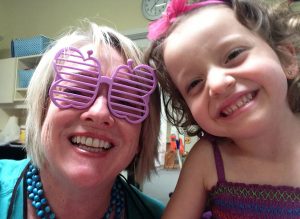 Christine recalls how much she enjoyed working with Jacquie and Sofia. “I knew Jacquie had a thourogh understanding of what my therapy was trying to achieve,” Christine said. “I could be very rigorous with Sofia, because I knew Mom and the whole family were completely on board. We used phrases like ‘go slow now, so you can go fast later,’ which let Sofia know that we were invested in her for the long game.”
Christine recalls how much she enjoyed working with Jacquie and Sofia. “I knew Jacquie had a thourogh understanding of what my therapy was trying to achieve,” Christine said. “I could be very rigorous with Sofia, because I knew Mom and the whole family were completely on board. We used phrases like ‘go slow now, so you can go fast later,’ which let Sofia know that we were invested in her for the long game.”
“Every modality doesn’t work for every child,” Jacquie made sure to emphasize. Though starting Sofia on physical therapy was low-risk, the family also made the deeply personal decision to have Sofia undergo Selective Dorsal Rhizotomy surgery. She was five and a half years old. During this highly invasive surgery, nerves are cut in the lower spinal cord to relax hypertense leg muscles characteristic of Sofia’s form of CP.
Jacquie adopted the approach Sofia’s physical therapy team employed — that perfect practice makes progress. Sofia’s therapy team set reasonable, achievable goals aimed to build up Sofia’s confidence. Jacquie stopped comparing Sofia to other kids and began looking for ways to help Sofia become her best possible self. This included making Sofia’s at-home therapy regimen as entertaining as possible.
For instance, to practice Sofia’s fine motor skills, Jacquie created a fun game where Sofia made flowers out of popsicle sticks and paper. Jaquie had Sofia “plant” the flowers around the house. After a few days, Sofia would then practice walking around by “picking” the flowers.
“I’ve always felt that her only job is to be a kid,” Jacquie said. “And my job is to understand her and to figure out how I can make the work she needs to do playful.”
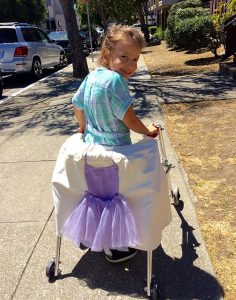 While practicing stepping using her walker at Crissy Field in San Francisco, Sofia remarked to her mother that people would turn away even if she waved to them. Troubled by these interactions, Jacquie wanted to have people look beyond the device and see her girl. She came up with the idea to sew a ballet-inspired cape around Sofia’s walker, hoping to destigmatize her daughter’s condition and to showcase Sofia’s personal interests versus her physical difference.
While practicing stepping using her walker at Crissy Field in San Francisco, Sofia remarked to her mother that people would turn away even if she waved to them. Troubled by these interactions, Jacquie wanted to have people look beyond the device and see her girl. She came up with the idea to sew a ballet-inspired cape around Sofia’s walker, hoping to destigmatize her daughter’s condition and to showcase Sofia’s personal interests versus her physical difference.
Not only did Sofia love her custom cape, Jacquie said people were more comfortable approaching and engaging with Sofia — the cape was a conversation starter. A few parents approached Jacquie and asked if she could make capes for their child’s walker. What began as a few requests grew into full-fledged non-profit organization: WAWOS.
Jacquie founded WAWOS, short for “We’re All Working On Something,” in October 2017 to celebrate children with Cerebral Palsy and related neuromuscular delays. Through the organization’s flagship WAWOS Wear cape program, WAWOS has given away over 1,500 capes to children who use assistive devices. In November of 2019, WAWOS launched the WAWOS Wishes program: providing $50,000 to 20 non-profits across the country that provide inclusive recreational opportunities for otherly-abled children.
“She is the light that led me to launch the non-profit,” Jacquie said of her daughter. “Sometimes when people say, ‘Oh Jacquie you’re so inspiring,’ I say, ‘I’m just trying to keep up with Sofia.”
Even the name WAWOS stems from her daughter, Sofia. During a particularly tough day of home physical therapy, Sofia dejectedly asked why she should bother continuing working so hard on something that came easily to other kids. Jacquie simply replied, “We’re all working on something.”
In this time of COVID-19, the Robison Family is practicing extreme social distancing, given Sofia’s childhood asthma. WAWOS has added mask making to walker cape creation, and has delivered 250+ masks to non-medical essential workers. But as always, Jacquie has found a positive in the uneasy situation, finding new time to bond with Sofia over this creativity.
“Honestly, it’s very meaningful to have found some purpose in this small way, to contribute at this difficult, unprecedented time.” From first having received Sofia’s diagnosis, I’ve learned that leaning into the hurt of an unexpected situation can lead you to a place of providing help. Use your hurt to help and heal.”
